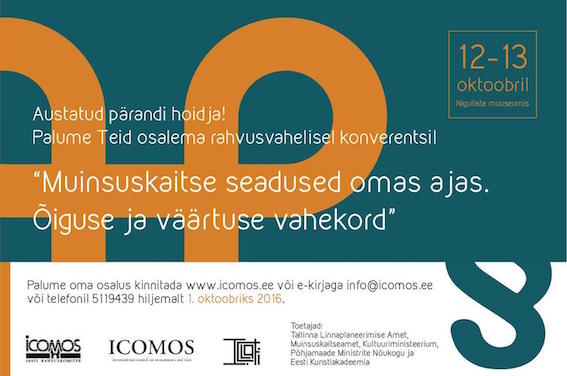Historical Perspective of Heritage Legislation. Balance Between Laws and Values/ Muinsuskaitse seadused omas ajas. Õiguse ja väärtuse vahekord
Conference commemorating the 350th Anniversary of the 1666 Conservation Act by King Charles XI of Sweden and 50th Anniversary of Tallinn Old Town Conservation Area
2016. aastal möödus vastavalt 350 ja 50 aastat Rootsi kuninga Karl XI muinsuskaitse seadusest ja Tallinna muinsuskaitseala loomisest.Väärikaid tähtpäevi tähistati rahvusvahelise konverentsiga “Muinsuskaitse seadused omas ajas. Õiguse ja väärtuse vahekord” 12.-13. oktoobril 2016.
Conference commemorating important legislative cornerstones brought together experts on heritage, administration and legal issues from all over the World. The organisers of the conference were ICOMOS Estonia, ICLAFI and Nordic- Baltic ICOMOS’s in cooperation with Tallinn Urban Planning Department, Estonian Academy of Arts and National Heritage Board and with the help of Ministry of Culture and Nordic Council of Ministers.
The aim of legislation through all times is to regulate peoples’ interests and behaviour and thus it reflects the relevant problems of the times. The rules that highlight the common values also serve as the generators of these. The target of the conference is to discuss the correlation between legislation and common values.
Conservation Act by King Charles XI of Sweden in 1666 is not the earliest heritage protection act in Europe, but very influential as the Swedish Kingdom of those days included the present Nordic and Baltic countries (Sweden, Finland, Estonia and parts of Latvia, Germany and Russia) and is the ground of current legislation in Sweden and elsewhere. And it is important because of its essence – it did not cover only the property of the King and the Church, but also the Viking age heritage, folk art and tales, ruins of buildings that are out of use, sacred groves and springs etc. The Act regulated the excavations of old graves; it forbid the reuse of ancient monuments as building materials, and the relocation of monuments, etc. Most of the issues covered are still relevant today. For example one can see the ties between forbidding excavation of the graves except for scientific purposes with the contemporary problem of metal detectorists and the obligation to safeguard the valuables from the widespread illicit trade.
Tallinn Old Town Conservation Area was first of the kind in former Soviet Union setting regulations to the development processes and has influenced not only the development but also the common understanding of heritage values. The creation of conservation zone was essential to preserve a unique medieval hanseatic town till now-a-days and develop it as a valuable and respected historical environment.

